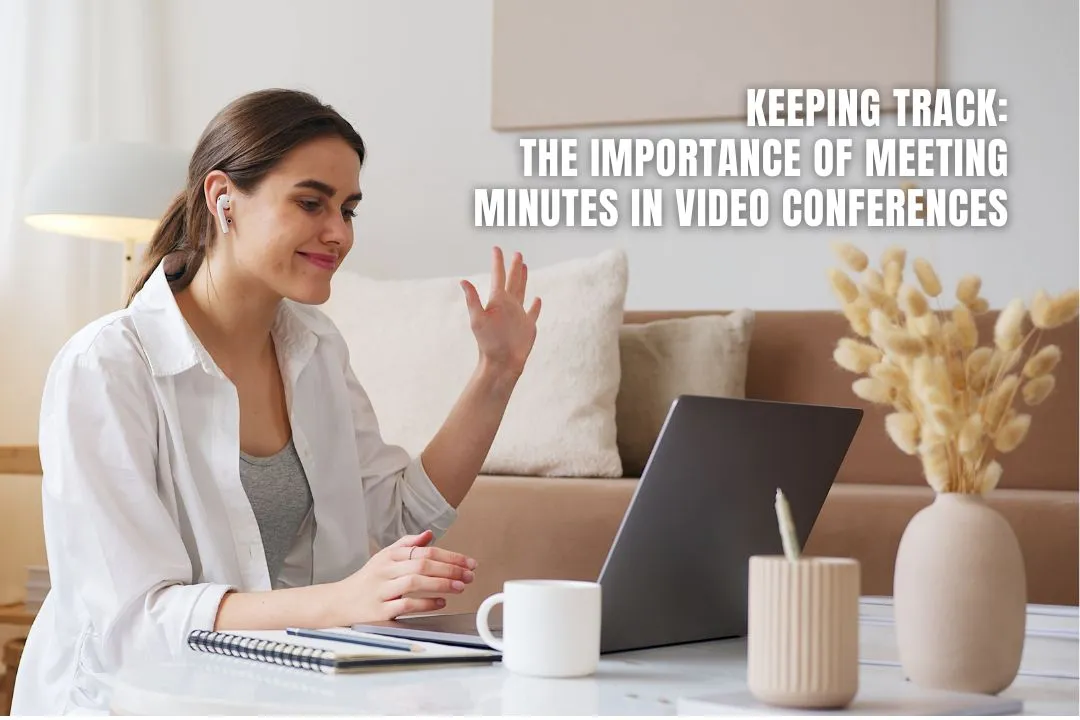November 8, 2024

In video conferences, meeting minutes serve as an essential tool for capturing key discussions, decisions, and action items, ensuring clarity and accountability among participants. They help keep everyone aligned by recording the agreed-upon tasks and deadlines, making it easy to track progress and follow up on responsibilities. Additionally, meeting minutes provide legal protection, acting as an official record that can resolve disputes if disagreements arise. With video conferencing increasingly used for collaboration, effective minute-taking has become more important than ever to maintain organisational memory and ensure transparent communication.
Meeting minutes play a crucial role in video conferences, ensuring that all participants are on the same page. They serve as a record of discussions and decisions made during the meeting. Here are some key functions of meeting minutes:
Meeting minutes are not just a formality; they are essential for effective communication and organisational memory.
In summary, meeting minutes are vital for maintaining clarity and accountability in video conferences, ensuring that everyone understands their roles and responsibilities moving forward.
Utilising technology can greatly enhance the efficiency of minute-taking. Here are some tips:
It’s crucial to remain neutral when taking minutes. Follow these guidelines:
If you’re unsure about something discussed, don’t hesitate to ask for clarification. This ensures accuracy in your notes. Here’s how:
Effective minute-taking is about capturing the essence of discussions while ensuring clarity and accuracy. Remember, the goal is to provide a reliable record of what transpired.
Taking minutes during video conferences can be tricky. Here are some common challenges and ways to tackle them:
Minute-taking is not just about writing down what is said; it’s about creating a clear and accurate record that everyone can refer back to.
By being aware of these challenges and using these strategies, you can enhance your minute-taking skills and contribute to more effective meetings.
In the UK, it is a legal obligation for limited companies to maintain meeting minutes for all board and general meetings. These minutes serve as an official record of discussions and decisions made during the meeting. Failure to comply with this requirement can lead to legal issues for the organisation. Key points to remember include:
Meeting minutes play a crucial role in preserving the history of an organisation. They help in:
In case of disagreements or disputes, meeting minutes can serve as vital evidence. They help clarify:
Meeting minutes are not just a formality; they are essential for legal protection and maintaining a clear record of organisational decisions.
In summary, meeting minutes are not only a legal requirement but also a valuable tool for ensuring accountability and transparency within an organisation. They help in tracking progress, supporting organisational memory, and providing evidence in case of disputes.
Using software designed for minute-taking can greatly enhance your efficiency. Here are some popular options:
Having a template can streamline the process of taking minutes. Consider these tips:
Sometimes, it’s beneficial to record meetings. Here’s how to do it effectively:
Effective minute-taking is not just about writing down what is said; it’s about capturing the essence of the discussion and the decisions made. An impartial minute taker can help create a comfortable environment for all participants, allowing them to focus on the meeting itself.
By employing these tools and techniques, you can ensure that your meeting minutes are accurate, clear, and useful for all attendees.
Before the meeting starts, it’s essential to go through the agenda and any related documents. This helps you understand the topics that will be discussed. Here are some steps to follow:
A well-organised workspace can make a big difference in your minute-taking. Consider these tips:
Knowing the purpose of the meeting is crucial for effective minute-taking. Here’s how to prepare:
Being well-prepared not only helps you take better minutes but also contributes to a more productive meeting overall.
Once the meeting is over, it’s important to finalise the minutes quickly. Here are some steps to follow:
Before sharing the minutes, you should:
After approval, distribute the minutes to all relevant parties. Consider these methods:
Keeping everyone informed is key to effective communication. Distributing the minutes promptly helps ensure that all participants are on the same page regarding decisions and action points.
In summary, keeping track of meeting minutes during video conferences is essential for any organisation. These minutes not only help clarify decisions made but also outline the next steps and who is responsible for them. They serve as a reminder for attendees about their tasks and ensure everyone is accountable. Additionally, reviewing past minutes allows participants to see progress and understand what has been achieved since the last meeting. By documenting discussions and decisions, minutes provide a clear record that can be referred back to, especially for those who missed the meeting. Overall, effective minute-taking is a vital practise that supports transparency and enhances the efficiency of future meetings.
Meeting minutes are notes taken during a meeting that summarise the main discussions, decisions, and actions. They are important because they provide a clear record of what happened, help keep everyone accountable, and can be used for future reference.
Before the meeting, review the agenda and any materials provided. Make sure your workspace is set up for taking notes, and understand the main objectives of the meeting.
You can use software like Google Docs or Evernote for digital notes. Templates can help structure your minutes, and recording the meeting can provide additional accuracy.
To ensure accuracy, focus on summarising key points rather than writing everything down. Clarify any unclear points during the meeting and review your notes soon after to fill in any gaps.
Include the date, time, location, attendees, decisions made, action points, and any follow-up items. Avoid personal opinions and stick to the facts.
After finalising the minutes, get approval from the chairperson and then share them with all attendees via email or a shared document platform.